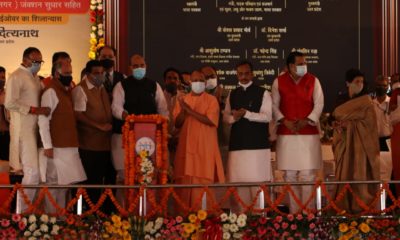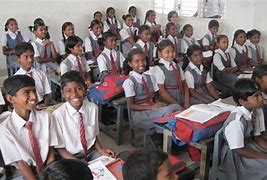Feature
Lucknow to elect its first ever woman mayor in 100 years on Sunday

Lucknow: The city of Nawabs, Lucknow is going to break the glass ceiling on Sunday by electing its first-ever woman mayor in past 100 years by making it history in the field of politics.
All the parties have fielded female candidates after the Lucknow mayoral seat was reserved for women.
The civic polls will be held in the state capital on Sunday in the second leg of the three-phase municipal elections across Uttar Pradesh.
The city got its chance to elect a woman mayor 100 years after the Uttar Pradesh Municipalities Act came into existence.
“But better late than never,” says BSP candidate Bulbul Godiyal.
The Bahujan Samaj Party is contesting the civic polls on its party symbol-elephant-after 17 years.
“Our time has come,” feels Sanyukta Bhatia, the BJP mayor candidate.
In past 100 years Lucknow is going to elect its first woman mayor on Sunday:
The Samajwadi Party has selected Meera Vardhan, kin of educationist Acharya Narendra Dev and the Congress has pitched Prema Awasthi, wife of the late former Congress legislator, Surendra Nath.
The Uttar Pradesh Municipalities Act came into being in 1916 and Barrister Syed Nabiullah became the first Indian to head the local body.
In 1948, the UP government changed the electoral nature of the local body and introduced the concept of administrator and Bhairav Datt Sanwal (ICS) was appointed to the post.
In 1959, the UP Municipalities Act, 1916, was replaced by the Uttar Pradesh Municipal Corporation Act, paving the way for the formation of the municipal corporation (nagar mahapalika) in Lucknow on February 1, 1960.
It was on the intervention of the Allahabad High Court in 1989 that the government announced local bodies polls.
An amendment in the Constitution accorded the status of municipal corporation to Lucknow’s local body retrospectively from May 31, 1994.
Provisions were made in the Municipality Act of 1959 to allow citizens to elect a mayor. Provision of reservation to women, SCs, STs and OBCs was also made on a rotational basis.
Entertainment
Meghalaya Reserves Legalized Gambling and Sports Betting for Tourists

The State Scores Extra High on Gaming-Friendly Industry Index
Meghalaya scored 92.85 out of 100 possible points in a Gaming Industry Index and proved to be India’s most gaming-friendly state following its recent profound legislation changes over the field allowing land-based and online gaming, including games of chance, under a licensing regime.
The index by the UK India Business Council (UKIBC) uses a scale of 0 to 100 to measure the level of legalisation on gambling and betting achieved by a state based on the scores over a set of seven different games – lottery, horse racing, betting on sports, poker, rummy, casino and fantasy sports
Starting from February last year, Meghalaya became the third state in India’s northeast to legalise gambling and betting after Sikkim and Nagaland. After consultations with the UKIBC, the state proceeded with the adoption of the Meghalaya Regulation of Gaming Act, 2021 and the nullification of the Meghalaya Prevention of Gambling Act, 1970. Subsequently in December, the Meghalaya Regulation of Gaming Rules, 2021 were notified and came into force.
All for the Tourists
The move to legalise and license various forms of offline and online betting and gambling in Meghalaya is aimed at boosting tourism and creating jobs, and altogether raising taxation revenues for the northeastern state. At the same time, the opportunities to bet and gamble legally will be reserved only for tourists and visitors.
“We came out with a Gaming Act and subsequently framed the Regulation of Gaming Rules, 2021. The government will accordingly issue licenses to operate games of skill and chance, both online and offline,” said James P. K. Sangma, Meghalaya State Law and Taxation Minister speaking in the capital city of Shillong. “But the legalized gambling and gaming will only be for tourists and not residents of Meghalaya,” he continued.
To be allowed to play, tourists and people visiting the state for work or business purposes will have to prove their non-resident status by presenting appropriate documents, in a process similar to a bank KYC (Know Your Customer) procedure.
Meghalaya Reaches Out to a Vast Market
With 140 millions of people in India estimated to bet regularly on sports, and a total of 370 million desi bettors around prominent sporting events, as per data from one of the latest reports by Esse N Videri, Meghalaya is set to reach out and take a piece of a vast market.
Estimates on the financial value of India’s sports betting market, combined across all types of offline channels and online sports and cricket predictions and betting platforms, speak about amounts between $130 and $150 billion (roughly between ₹9.7 and ₹11.5 lakh crore).
Andhra Pradesh, Telangana and Delhi are shown to deliver the highest number of bettors and Meghalaya can count on substantial tourists flow from their betting circles. The sports betting communities of Karnataka, Maharashtra, Uttar Pradesh and Haryana are also not to be underestimated.
Among the sports, cricket is most popular, registering 68 percent of the total bet count analyzed by Esse N Videri. Football takes second position with 11 percent of the bets, followed by betting on FIFA at 7 percent and on eCricket at 5 percent. The last position in the Top 5 of popular sports for betting in India is taken by tennis with 3 percent of the bet count.
Local Citizens will Still have Their Teer Betting
Meghalaya residents will still be permitted to participate in teer betting over arrow-shooting results. Teer is a traditional method of gambling, somewhat similar to a lottery draw, and held under the rules of the Meghalaya Regulation of the Game of Arrow Shooting and the Sale of Teer Tickets Act, 2018.
Teer includes bettors wagering on the number of arrows that reach the target which is placed about 50 meters away from a team of 20 archers positioned in a semicircle.
The archers shoot volleys of arrows at the target for ten minutes, and players place their bets choosing a number between 0 and 99 trying to guess the last two digits of the number of arrows that successfully pierce the target.
If, for example, the number of hits is 256, anyone who has bet on 56 wins an amount eight times bigger than their wager.





























